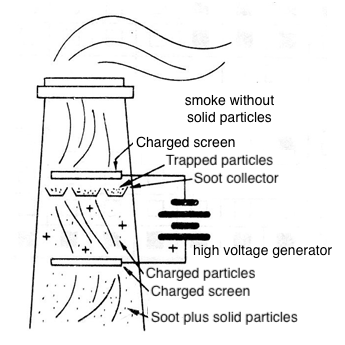The electrostatic filters or precipitating filters already find a wide range of applications in industry, medical and even domestic environments. These filters precipitate particles that are suspended in air or smoke with purifying effects.
For example, in industry they can be placed in chimneys to precipitate solid particles (soot) preventing them from being released into the atmosphere. In industrial kitchens, for example, they precipitate particles responsible for odors, thus eliminating them.
For medical applications, filters can assist in air purification by precipitating particles that include the presence of microorganisms.
How it Works
To better understand the working principle of this type of filter, let's take as an example a filter used in a factory chimney as shown in Figure 1.

We then started from two screens which are electrically charged with a high voltage from a special source.
As shown in Figure 2, these screens are arranged in such a way that the polluted air initially passes through one of them, which is positively charged.
Hence, particles acquire positive charges as they pass through the screen. In addition to being repelled by the screen, the particles are carried by the air stream, finding a second metal screen which will be charged with electricity of opposite polarity.
The result is a strong attraction which ends up trapping particles which accumulate and gather, falling into a reservoir or holding box. The air without these particles flows freely into the atmosphere or ambient air.
Note that the efficiency of the filter depends on the ability of the target particles to retain the charges and also on the screen used.
Medical Applications
There are several electrostatic filters or precipitators indicated for medical applications. We also found several works on the Internet reporting the advantages of its use in medical applications.
These applications include isolation rooms, operating rooms, and general medical environments where the use of filtered air in an environment is highly recommended.
The commercial types propose to deliver air to their outlets with up to 99% purity, thus eliminating the suspended particles which include the presence of microorganisms.
An important point that must be emphasized is that in many cases the presence of high voltage can also be sufficient so that, due to the corona effect that we explored in our article on ozonizers (it generates a certain amount of ozone with intense action on microorganisms).
In the work environment itself, the elimination of particles which can be harmful to people, as in industrial environments where there are particles resulting from machining processes must be considered.
However, it is necessary to take into account some precautions when it is intended to assemble or use a filter of this type.
One of them is to be attentive to the filtering elements (screens) which can easily be blocked by the accumulated particles, thus decreasing their efficiency. Periodic checking, with subsequent cleaning, is important.
In Figure 3, we have an example of a simple structure which can be implemented in a ventilation system, although there are commercial types developed even under standards which must be preferred in the case of medical facilities.
For an experimental or small application, for a small environment, T1 can be a car ignition coil.
In our Circuit Bench section, we have dozens of circuits from very high voltage sources which can be used in an experimental electrostatic filter project.






